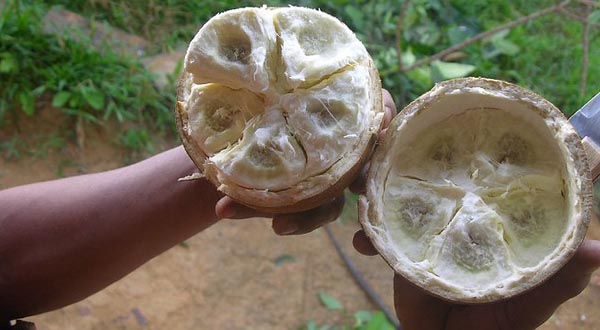Even though cupuacu is mostly grown in Brazil, I first encountered it while traveling in Peru. It’s sold at juice bars along the street and an ingredient in many desserts. Lately, cupuacu has become popular around the world because of its many health benefits, especially for skin and hair.
What is Cupuacu?
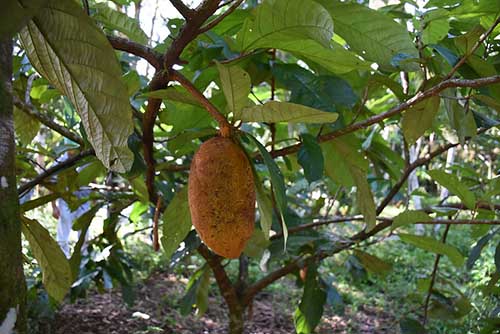
Cupuacu (pronounced coo-poo-asoo) is a tree related to cacao which grows in the Amazon basin, particularly in the northern parts of Brazil. The trees form large brown fruits which can be over 3lbs each. The fruits have hard, slightly-fuzzy shells which you can crack open with a hammer. Inside, you’ll find a delicious-smelling creamy pulp surrounding about 30-50 seeds.
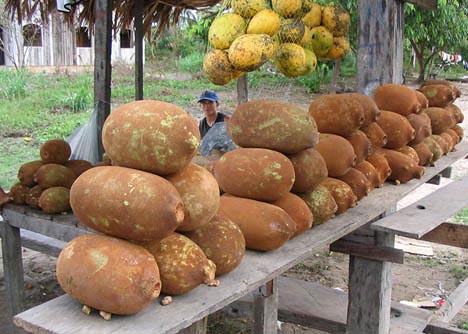
What Does Cupuacu Taste Like?
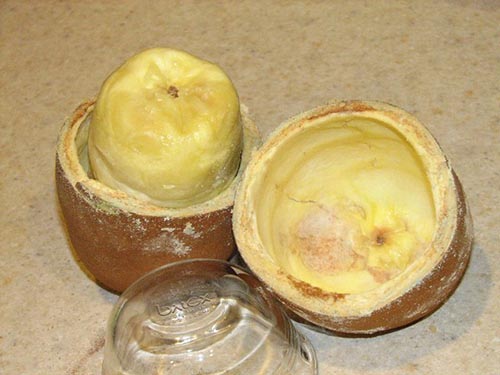
The yellow cupuacu pulp is incredibly sour and tangy but it also has a very intricate flavor profile. People describe it as tasting like pineapple, pear, sour sop and banana. The creamy texture of cupuacu pulp is a bit reminiscent of coconut.
You can eat cupuacu seeds raw. They are slightly bitter and earthy tasting. However, it’s more common to separate the seeds from the pulp. The seeds are fermented and dried (like cacao) to make cupulate, which tastes a like chocolate but with tangy, fruity undertones.
Other Names for Cupuacu
Cupuaçu is the Portuguese name for the fruit used in Brazil. In other parts of the world, the fruit might go by one of these names.
- Theobroma grandiflorum (Latin)
- Cupuazu (Spanish)
- Cupuassu
- Cupuazú
- Cupu assu
- Copoasu
Cupuacu Products
Cupuacu is used to make several different products. They differ based on which part of the fruit was used (seeds or pulp) and how they were processed.
Butter
Cupuacu seeds are used to make cupuacu butter (sometimes also called cupuacu oil). They are typically cold-pressed to extract a nutrient-rich oil. The oil can be used for cooking but it’s most popular as a beauty treatment for skin and hair.
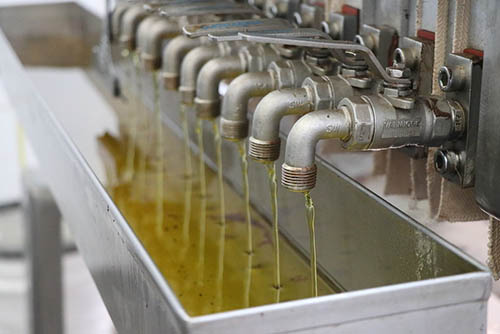
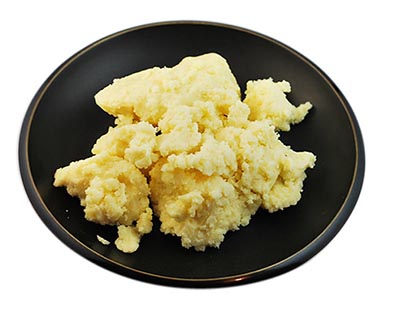
Juice
Cupuacu juice is actually more like a smoothie. It is made by blending cupuacu pulp with water. Sugar is usually added to counteract the sour taste. It tastes a bit like melted sherbet.
Powder
Because it’s very difficult to ship cupuacu fruit abroad, some manufacturers have started making cupuacu powder. The powder is made by drying capuacu pulp and blending it into a powder. You then add water to the powder to make a juice or add the powder to smoothies as a supplement. Unfortunately, cupuacu powder is quite expensive. Prices are usually $40 to $100 for a pound. This brand – which sells 70oz (4.3lb) packages – is the most affordable option I’ve found. If you want to try a smaller amount, this brand is a good option.
Cupulate
Cupulate is a chocolate alternative made from cupuacu. It is made in a very similar way as chocolate: the cupuacu beans are dried and fermented before being ground. Cupulate can be drunk like hot chocolate or made into bars.
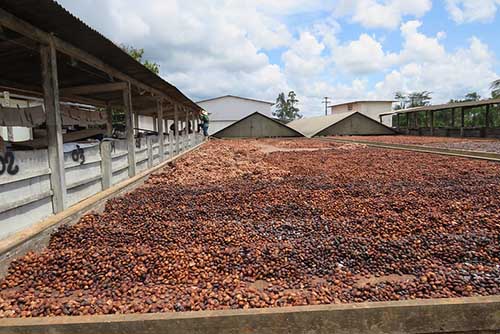
Benefits of Cupuacu
There are a lot of benefits to using cupuacu butter or pulp – and not just for health. Here are the main reasons you might want to add cupuacu to your life.
1. Excellent Moisturizer
Cupuacu butter can absorb huge amounts of water: approximately 450% of its weight. This is much higher than shea butter (289%) and lanolin (250%). As a result, cupuacu butter is particularly good at trapping moisture in the skin.
Because it has a low melting point, cupuacu butter absorbs into the skin very quickly without leaving any unpleasant residue. (1, 2)
2. Anti-Inflammatory
Cupuacu seeds contain high levels of fatty acids, including stearic acid, oleic acid, palmitic acid and arachidic acid. The seeds and pulp also contain high amounts of antioxidants, including flavonoids, theograndins and polyphenols.
These compounds can help reduce inflammation. Apply cupuacu butter directly to the skin to reduce inflammation from psoriasis or eczema or speed up wound healing. Take cupuacu internally to fight inflammation throughout the entire body. (3, 4, 5)
3. Protects from UV Rays
Cupuacu butter absorbs UV rays (including both UVB and UVC radiation). This makes it a natural barrier against damage to your skin and hair. There are also many reports that the antioxidants in cupuacu butter can protect the skin from other types of damage, such as pollution and secondhand smoke in the air, thus helping protect against signs of aging. (6, 7)
4. Restores Damaged Hair
The fatty acids in cupuacu butter absorb well into hair, helping keep hair hydrated. One study found that applying cupuacu butter can help repair damaged hair as well as argan oil (8). As a result, cupuacu butter is becoming particularly popular for caring for black natural and textured hair.
5. Balances Gut Flora
The potent antioxidants in cupuacu (especially a type of polyphenol called Proanthocyanidins) are very good for your digestive system. They antioxidants make it to the stomach and small intestine where they help balance gut flora. Because gut dysbiosis (unbalanced gut flora) is linked to conditions ranging from autism to IBS to skin disorders, taking cupuacu supplements could help improve health in multiple ways. (9)
6. Boosts Energy and Focus
Like coffee, cupuacu seeds contain caffeine – but in lower amounts. Cupuacu also contains the compounds theobromine. It is also a stimulate like caffeine, but doesn’t act on the central nervous system. It is much more gentle and longer-lasting. As a result, cupuacu is a good alternative to coffee for people who want focus without the jitteriness that comes with coffee. (10, 11)
7. Sustainable Product
A lot of beauty products contain palm oil, silicones, and other ingredients which are bad for the environment. By contrast, cupuacu is a sustainable product. It is grown using agroforestry, which essentially combines native plant species together in a way which preserves biodiversity. This is crucial for counteracting the deforestation which is destroying the Amazon and contributing to global warming. (12, 13)
8. Supports Local Communities
Much cupuacu is grown by small farmers who work closely with manufacturers or even produce small artisan batches of cupuacu themselves. Much like with guayusa production, this provides locals with an additional source of income and an alternative to logging. You may also see the terms “bean-to-bar” used with cupulate products. The terms mean that the cupulate was made by a single manufacturer. The term “tree-to-bar” means the maker also grew the cupuacu beans too. (14)
9. Other Possible Benefits
Cupuacu might also have these health benefits, but there currently isn’t enough research to support the claims.
- Burn fat
- Fight diabetes
- Increase libido
- Improve fertility
Best Brands of Cupuacu Butter
There are a lot of brands which incorporate cupuacu butter into their products, such as conditioners or lip balm. Because cupuacu butter is fairly pricy, a lot of people like to buy pure cupuacu butter and mix it with other oils and a few drops of essential oils to make their own blends. Below are some of the best brands of cupuacu butter for your skin.
1. Candela Organic Raw Cupuacu Butter

2. Vitae Organics Cupuacu Butter
Harvested from the Brazilian Atlantic forest, this cupuacu butter is 100% raw and organic. The company has a good reputation for making pure plant butters with methods that retain nutrients. It’s available in 4oz packages.
3. Dr. Adorable Raw Cupuacu Butter
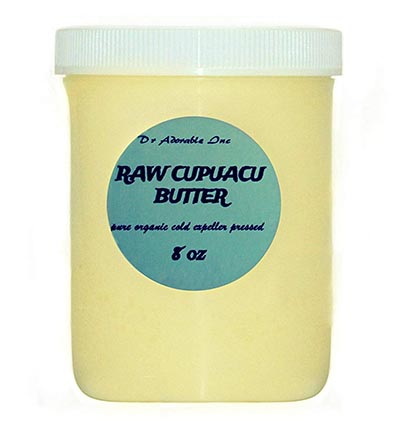
Here’s another brand of 100% pure cupuacu butter. I also seems to be a great quality product. The only slight issues are that there isn’t much info about the company available and they don’t publicize whether they use Fair Trade practices or not. It’s more affordable than some other brands.
4. Raw Shea and Cupuacu Moisturizing Exfoliator

How to Use Cupuacu Butter
You can use cupuacu butter by itself: simply rub it directly onto your skin or lips. Because cupuacu butter is a bit pricy, some people like to mix it with other butters or oils to make a custom blend. Here are some ideas.
- Lip balm (DIY Brazilian Kiss): In a double boiler, add 50/50 cupuacu butter and beeswax. Let them melt and then mix together. Add a few drops of acai oil, rosemary oil and aloe vera (optional). Pour the mixture into an empty lip balm tin.
- Hair mask: In a double boiler, melt 1-2 Tbsp of cupuacu butter. Remove it from the heat and add 1 Tbsp of aloe vera gel. Apply the mixture to your hair and let it sit for at least 30 minutes. You can also use mashed avocado or honey instead of aloe vera gel.
- Body butter: To make cupuacu more spreadable, use a double boiler to mix it with a softer or more liquidy plant oil. Maracuja oil, Pracaxi oil, coconut oil, hemp seed oil and jojoba oils are all good options. The final product should be approximately 50-80% cupuacu.
“AgroBrazil” (CC BY-NC-SA 2.0) by CNA Brasil,
“Delicious Cupuaçu” (CC BY-NC-SA 2.0) by Paulo Moreno,
“IMG_7465” (CC BY-NC 2.0) by SociobioAmazônia,
“Cupuaçú” (CC BY-NC 2.0) by SociobioAmazônia,
“IMG_7513” (CC BY-NC 2.0) by SociobioAmazônia,
“cupuacu-butter” (CC BY-ND 2.0) by cupuacu-fruit
“Cupuacu Butter” (CC BY-ND 2.0) by cupuacu-fruit,
“cupuacu2” (CC BY-ND 2.0) by cupuacu-fruit
Resources:
https://www.theguardian.com/lifeandstyle/2014/apr/17/cupuacu-brazil-alternative-to-chocolate
https://www.sciencedirect.com/science/article/pii/B9780128031384000216
https://www.sciencedirect.com/science/article/pii/B9780128158517000036
https://dev.amazonoil.com.br/en/cupuacu-theobroma-grandiflorum/
https://hort.purdue.edu/newcrop/1492/cupuacu.html

